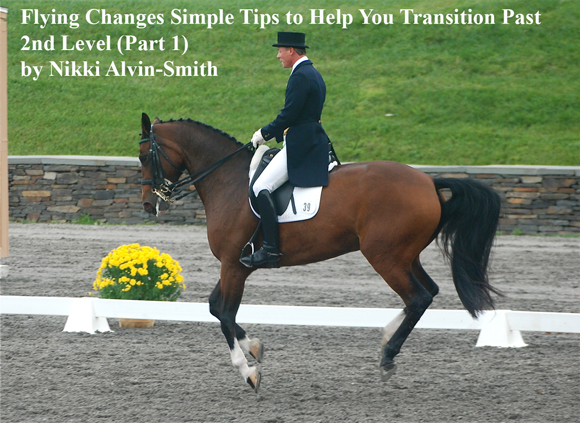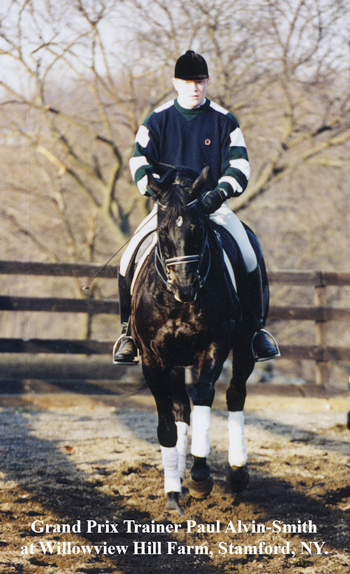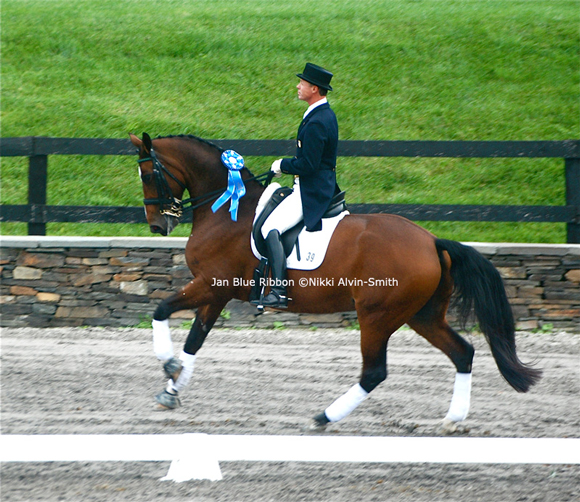Flying Changes Simple Tips to Help You Transition Past 2nd Level (Part 1)
by Nikki Alvin-Smith

Over the years many students have come to us stuck on that huge plateau that is 2nd level dressage. Their horses have excelled ( they say) at all the 2nd level tests and have a counter canter to die for - so why they ask, can't my horse master the change.
We've all seen it. The rider jumping left to right on the saddle with the horse's rear swinging anxiously with no semblance of straightness, the weird and wonderful contortions of both horse and rider. The rider's lower leg bouncing up toward the hip or stifle, their holding hands dragging the horse to the new inside, hands lifted to their chins, and all the other maladies that await you when you are learning the changes and how to school them.
First rule. It is very helpful, though not absolutely necessary, to have ridden the flying change (s) on a schoolmaster with a ground person that knows of what they speak. When you yourself have no idea of the 'feel' and the subtle change in balance of the horse beneath you with your required timing of the aids, teaching flying changes to your horse is much harder than it needs to be.
The second rule, and the one most often overlooked, is that just because the horse has a solid, well scored counter canter, does not mean he is supple or strong enough for changes. The testing is well based to build the horse, but each horse has a different mentality and conformation, and must be treated individually. We'll look at conformational issues in Part Two.
Some of the greatest flying changes you see are actually in the awards ceremonies. The horses know their job for the day is done, the riders are happy and relaxed. If you haven't see the footage of Dr. Reiner Klimke and Ahlerich at Madison Square Garden doing changes, hat and roses in hand, you've missed a treat. Check it out on the video The Magic of Classical Dressage Pas de Deux and Pas de Trois. The great Dr. Reiner Klimke would say that your horse must 'pop' in each canter stride. The horse must be 'up' and in front of the leg. I totally agree. An earthbound canter will result in changes that are late behind ( if you achieve them at all), and a four beat or slow/lazy canter will not make a clean change possible either. Another great team to watch is Karen Rehbein and Donnerhall who are showcased also on the DVD above, though as a breeder of Donnerhall babies in the past I've got to say, get the Donnerhall DVD. Some real wow factors there too. Anyway - you get the idea, watch great riders doing great changes and feel that canter they have created.
Common faults that occur include the rider leaning forward, over compensating for the change in balance, upsetting the new balance, holding the reins and not giving the reins in the right moment in a following manner, too much bend in the neck of the horse, looking down, looking up, kicking, aids given too hard or at the wrong time. Yes, these are just a few of the pitfalls.
Another issue is once someone fools around trying to teach the horse the change before the stepping stones are in place, the horse may become fearful and bolt off. A habit that is hard to break. More on that later.
The important Do's to create a balanced and through flying change. But do your homework first, and get your eye 'in' so you have a good image in your brain before you begin.
Well it's been a mad time dashing about downstate to ride some of the Willowview Hill International 2012 Elite Collection and I have had plenty of time not just riding but watching to think about what kinds of problems folks have training flying changes. One of the mares in the collection is a Rohdiamont/Donnerhall Prix St George horse and sitting on her changes were to die for. I can't claim to have put the flying changes in to this particular horse but I can tell you from years of training including from the mare's trainer and mine, Greta Kemmer, that when a horse is properly trained I sure know it. I think flying changes are one of my favorite things of all to do and there is nothing to compare to the joy of having your horse succeed in passing this test of canter quality with flying colors.
Do you have trouble with flying changes? Don't despair. Here's a few hints to get you on the right track ( pardon the pun).
The quality of any movement in dressage is always determined by the quality of the movement before it, so it comes as no surprise that the flying change will be severely impacted by a prior poor canter step or incredibly enhanced by brilliant canter step set up.
So first off how do you make sure your canter is of good enough quality? Well it is not done by just schooling the canter. A good round enthusiastic collected canter will only be possible if your horse has mastered the lateral work in the trot. Canter quality requires suppleness. You need to be able to instantly straighten your horse by haunches in and out, shoulder in and out. You transition to canter from trot must be on the money. Aptly timed in your ask, with correct bend of the horse's neck and shoulder not bulging. You also need to work well on longitudinal bending i.e. extensions in trot and canter, especially important if your horse can be stiff backed and likes to fly off after attempting a flying change. But more on that later.
Once you have conquered that then work the same way in lateral work in the canter. Sure, you have shown 2nd level and perfected a decent sort of counter canter. But now you must have your horse yield softly in his head and neck to the opposite direction. Try this:-
Set up a nice active round canter on the left rein on the right lead i.e. counter canter. Your horse will have his head to the outside of the arena. Now, bring his head inside while still maintaining your leg and body position for counter canter position. If he breaks to the trot, just be patient. Set it up and try again. A few good strides are all that are needed then back to walk and reward your horse with a pat and a free rein. Repeat. Do this in different parts of the arena, do it out on the trail.
Once you can do this well - and maintain it for a good amount of the long side, you can work more on your lateral canter work. You must be able to do a change of hand in the half pass through a simple change, and have mastered simple changes for what comes next. Don't forget not to overdo the shoulder in position, it's more a shoulder fore position in canter. Work on lots of canter and walk transitions and be certain that the canter is expressive and uphill. You only have a moment of suspension and a horse that is earthbound, out of balance or rushing and not in true self carriage will not be able to oblige.
When I begin teaching changes to a horse, I prefer to start with changes in figure eight with small circles, about 10 meters. I will use a collecting half halt as I reach the center of the circle, and do a simple change before heading onto the second part of the figure eight. My horse must do this well. With an active and uphill canter and without rushing or feeling panicked. Then we are ready to do a single flying change.
For this ensure that you time it right. You will change your legs and ask for the change at the moment the horse's leading front leg hits the floor ( the third beat of the canter) and is about to come off the ground. For example if you are cantering on the left lead, you will ask the horse to execute the change when his left front leg hits the floor. You will then be heading right on the second part of the figure eight. Most horses will happily oblige. You want the horse to be active and in front of your leg, very collected, almost as if he is waiting for you to let him change.
What are your aids? From left lead to right lead here's the routine:-
Collecting half halt, then as the leading front leg hits the ground begin with your seat and give a slight forward push with your right seat bone, this will give your horse the idea something is changing. Don't overdo it. It is a subtle aid. Keep your right leg active and squeezing on the girth to maintain activity. Your left leg will swing back slightly behind the girth to say to the new outside leg, hey - it's time to strike off..come on. With your hands you will want to have a very soft inside right rein to allow that shoulder to come through to make the change. The left rein will be very quickly closed, which will encourage your horse to stay in a uphill canter stride and his new outside hind leg will experience a very small moment of blocking. Release the closed left rein almost immediately.
You'll notice I have not suggested pivoting your seat, leaning in any direction or other antics. I would suggest you turn your head in the direction of change. Do not stiffen your jaw or drop your head or raise it up. Keep it level, jaw soft and preferably grin when you do it. And most of all, expect it to happen. Tease your horse into it by setting him up where he knows which change of direction is coming and where by doing repeat simple changes first and then inviting him to the flying change and to join you in the dance.
Here is a photo of my hubbie, Paul Alvin-Smith of Willowview Hill Farm. Note the softness in the rein, the focus of both horse and rider in quiet anticipation of the change. The canter is in harmony, the rider is well balanced with his legs in perfect position talking to the horse.

Breathing is also very important. Just as you take in your breath and hold it just a moment before an extension and let it out as you send your horse into his longer strides, so you will take your breath in and hold it momentarily as you give the collecting half half. When you have your horse primed and asking for that opportunity to change try and time your exhale to match the time of change in aids.
Practice this seated on the edge of a chair with the reins in front of you on another or have a friend hold them. Count the three beats of the canter if you like to get it in your head.
Your horse will probably oblige with the change and when he does it's important to relax him to the walk and reward him. I always hop off, praise lavishly and walk him out by hand to let him know how pleased I am and how brilliantly he has performed. However your horse may run off afterward in excitement. This is why I like to school it on circles too. Just stay in canter on the new circle until he calms down. If he switches in front but not behind, no worries. Bring him back to the walk calmly and go work on something else for a bit. Preferably something lateral that he is good at and enjoys, then come back and ask again.
If you are not getting it together then you must examine the quality of the canter stride and the horse's suppleness and balance. It is always in the basics. I will discuss on part three how to deal with tension and other possible impediments.
Here is a visual of the canter you are searching for quality wise, this time of Jan Ebeling and Rafalca. This canter can easily be collected the tiniest bit more to engage the topline even further at a moments notice. Note riders in both photos sit proudly with a straight soft back and and open chest with legs in close contact and elbow at a forty five degree angle to their bodies.

So this is a start for you. Follow along in our next edition for Part 2, how to ensure changes are straight and true and of excellent quality and how to progress to three's, two's and tempis and how to put your horse's individual temperament and conformation to work for you as well as how to work with problems that may arise.


